Main CPGW Record
Surname: HUTCHINSON
Forename(s): John
Place of Birth: Gressingham, Lancashire
Service No: 267194
Rank: L/Corporal
Regiment / Corps / Service: Duke of Wellington’s (West Riding Regiment)
Battalion / Unit: 'A' Coy 2/4th Battalion
Division: 62nd (2/West Riding) Division
Age: 37
Date of Death: 1918-07-20
Awards: ---
CWGC Grave / Memorial Reference: Addenda Extension
CWGC Cemetery: ---
CWGC Memorial: SOISSONS MEMORIAL
Non-CWGC Burial: ---
Local War Memorial: HIGH BENTHAM, YORKSHIRE
Additional Information:
John Hutchinson was the son of William and Annie Hutchinson, née Malley. William was born at Leck and Annie at Lancaster, Lancashire.
1881 Gressingham, Lancashire Census: John Hutchinson, aged 3 months, born Gressingham, son of William and Annie Hutchinson.
1891 Claughton, Lancashire Census: John Hutchinson, aged 10 years, born Gressingham, Lancashire, son of William and Annie Hutchinson.
1901 Bentham, Yorkshire Census: Batty's Farm - John Hutchinson, aged 20 years, born Gressingham, Lancashire, son of William and Annie Hutchinson.
1911 Euxton, Lancashire Census: Armetriding Farm - John Hutchinson, aged 30 years, born Gressingham, Lancashire. [John was employed by William Hodge, Farmer.]
The British Army Service Record for John Hutchinson (5118) exists but may be incomplete.
John is listed in the Nominal Roll of the 2/6th Battalion Duke of Wellington's (West Riding Regiment): 'D' Coy - L/Cpl J. Hutchinson.
When the 2/6th Bn Duke of Wellington's (West Riding Regiment) was disbanded on the 31 January 1918, John was transferred to the 2/4th Bn.
British Army WW1 Medal Rolls Index Cards: Pte John Hutchinson, 267194, W. Rid. R.
British Army WW1 Medal and Award Rolls: Pte John Hutchinson, 267194, 2/4 W. Rid. R. K. in A. 20.7.18.
Army Registers of Soldiers' Effects: L/Cpl John Hutchinson, 267194, 2/4th Bn W. Riding. Date and Place of Death: 20.7.18 France. To whom Authorised/Amount Authorised: Mother - Annie (Sole Legatee) £13 6s. 9d. Father - William £10 0s. 0d.
John took part in the Battle of Bullecourt, 3 – 17 May 1917. In a letter to his sister, Annie, on the 5 May (q.v.), he mentions that his Company is now about 40 strong.
John was killed in action near Marfaux during the Battles of the Marne, 1918, 20 July-2 August, at the Battle of Tardenois, 20-31 July.
In 2018 the CWGC commemoration for John was transferred from Loos Memorial to Soissons Memorial Addenda. His name will be removed from the Loos Memorial when the appropriate panel is next replaced.
A short biography of John is included in: ‘Bentham’s Part in the Great War 1914-18’ by Allan and Marilyn Hartley (2019).
Photograph courtesy of Sue Snell.
Data Source: Craven’s Part in the Great War - original CPGW book entry
View Entry in CPGW BookEntry in West Yorkshire Pioneer Illustrated War Record:
BENTHAM
HUTCHINSON, Lance Corporal John, West Riding Regiment, killed in action July 24, 1918.
---
Click the thumbnail below to view a larger image.

L/Corporal John HUTCHINSON
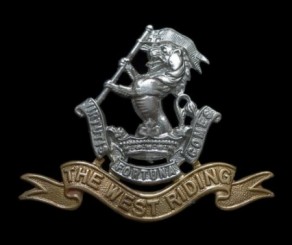
Regiment / Corps / Service Badge: Duke of Wellington’s (West Riding Regiment)
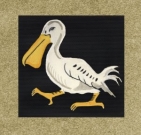
Divisional Sign / Service Insignia: 62nd (2/West Riding) Division
Data from Soldiers Died in the Great War 1914 - 1919 Records
Soldiers Died Data for Soldier Records
Surname: HUTCHINSON
Forename(s): John
Born:
Residence: Lancaster
Enlisted: Settle, Yorks
Number: 267194
Rank: L/Cpl
Regiment: Duke of Wellington's (West Riding Regiment)
Battalion: 2/4th Battalion
Decorations:
Died Date: 20/07/18
Died How: Killed in action
Theatre of War: France & Flanders
Notes:
Data from Commonwealth War Graves Commission Records
CWGC Data for Soldier Records
Surname: HUTCHINSON
Forename(s): John
Country of Service: United Kingdom
Service Number: 267194
Rank: Lance Corporal
Regiment: Duke of Wellington's (West Riding Regiment)
Unit: 2nd/4th Bn.
Age: 37
Awards:
Died Date: 20/07/1918
Additional Information: Son of William and Annie Hutchinson, of Batty Farm, Bentham, Lancaster.
View Additional Text
View Additional Text For Soldier Records
THE HISTORY OF THE 62nd (WEST RIDING) DIVISION 1914-1919 Volume 1, by Everard Wyrall (John Lane the Bodley Head Limited Vigo Street, London, W.)
THE BATTLE OF BULLECOURT:
3rd – 17th May, 1917.
During the three weeks following the first attack on Bullecourt on 11th April, the 62nd Division was engaged in trench warfare, and in preparing for another attack on the Hindenburg Line which had been ordered to take place on various successive dates and subsequently postponed, until it was definitely decided that Bullecourt should again be attacked on the 3rd May…
3rd MAY
In the centre of the Divisional front, the troops of the 186th Infantry Brigade reached their allotted places by 3-30 a.m., though during the evening of the 2nd, the enemy’s artillery had caused considerable trouble – all forward telephone and telegraph wires having been cut and communication interrupted. The Signallers, however, repaired them and communication was re-established. The 2/5th Duke of Wellington’s (Lieut.-Col. F.W. Best) were on the right, the 2/6th (Lieut.-Col. S.W. Ford) on the left: the 2/7th Battalion (Lieut.-Col. F.G.C. Chamberlin) was in rear of the 2/5th and the 2/4th (Lieut.-Col. H.E. Nash) in the rear of 2/6th.
Three Companies of the 2/8th West Yorks. were formed up in rear of the 2/4th and 2/7th Battalions Duke of Wellington’s Regt., the remaining Company of the 2/8th having been detailed as a carrying party was in rear of the three Companies. The 213th Machine Gun Company supported the 186th Brigade.
On the left of the Divisional front, held by the 187th Infantry Brigade, the 2/4th Battalion York and Lancs. Regt. (Lieut.-Col. F. St. J. Blacker) was on the right, the 2/5th King’s Own Yorks. Light Infantry (Lieut.-Col. W. Watson) with two Companies of the 2/4th Battalion (Lieut.-Col. R.E. Power) of the same Regiment in rear of the two front line battalions, and the remaining two Companies of the 2/4th K.O.Y.L.I. were in rear of the 2/5th Battalion, detailed for ‘carrying’ duties. The 208th Machine Gun Company was in support.
The taping and forming up operations were carried out without serious casualties and were completed by 3-30 a.m., but Lieut.-Col. F. St. J. Balcker, D.S.O., commanding the Hallamshires, was wounded on the forming up line.
Shortly after two o’clock in the morning the moon disappeared and the night turned to inky blackness, but fifteen minutes before Zero all was ready for the attack. At this period the enemy put down a very heavy barrage on the 185th Infantry Brigade, which gradually spread along the whole front.
At Zero the creeping barrage opened on the enemy’s position and the assaulting troops began to move forward immediately. But now an unexpected difficulty presented itself: the warm weather had baked the ground hard and as the shells fell, churning it up, clouds of dust filled the air, and with smoke from the guns, and the smoke bombs, the objectives were hidden from the advancing troops, and there was much loss of direction.
The 2/5th West Yorks. on the left of the 185th Brigade front speedily captured the enemy’s first line trench, the wire entanglements having been well cut. The 2/6th Battalion, however, was not as fortunate: Colonel Hastings’ Battalion had been met by very heavy machine-gun fire which caused many casualties, and in the smoke and confusion sheared off towards the left, overlapping the right of the 2/5th Battalion. Meanwhile the latter had pushed on towards the centre of the village and had established two posts, one at U.27.b.6.8. and the other at U.21.d.5.0. At this point touch was lost with the 2/6th Battalion, though it was eventually established about the church. A pigeon message timed 5-15 a.m. from an officer of the left Company of the third and fourth waves of the 2/5th Battalion which reached Divisional Headquarters stated that the writer was in the communication trench at U.21.d.5.5. with about forty of his men.
On the left of the 185th Infantry Brigade, the 186th had accomplished only part of its task. The 2/5th Duke of Wellington’s found the wire cut and no difficulty was experienced in reaching the second German trench of the first objective. Here touch was obtained with the left of the 185th Brigade, and maintained for several hours until broken by enfilade machine-gun fire from both flanks. But the 2/6th Duke of Wellington’s found the wire uncut and their attack was held up. Hostile shell-fire and the rear waves closing in on the leading waves, added to the confusion and all that could be done was to occupy some shell holes in front of the enemy’s wire. An attempt was then made to cut the second belt of wire, but again machine-gun fire from the north, and the enemy’s activity with bombs frustrated this endeavour and finally the shell-holes were established as posts.
The 2/5th Duke’s had by this time established themselves in the enemy’s front line trench from U.21.d.1.0. to U.20.d.2.4. and had been reinforced by the 2/8th West Yorks.
Similarly on the left of the 186th Brigade, the 187th had met with success – and failure. The 2/5th York and Lancs. Regt. reached its first objective without difficulty, but the 2/4th Battalion was hung up by the thick wire entanglements which were insufficiently cut. In seeking to find a way through the Battalion moved off to its left and became intermingled with the 2/5th Battalion, whose right flank was ‘in the air.’ At about 4-20 a.m. Lieut.-Col. W. Watson, commanding the 2/5th K.O.Y.L.I. was killed as he was gallantly rallying his men and leading them forward.
For a while no reports from the right flank of the attack were received at Divisional Headquarters, and nothing could be ascertained as to what was taking place in the village of Bullecourt. At 6-50 a.m. the situation was so obscure that the protective barrage was ordered to remain on the second objective until a further advance could be organized. A little later (at 7 a.m.) the situation of the 185th Brigade appears to be as follows: Posts had been established at U.21.d.5.5. with a certain number of men further east along the Support line at U.21.d.5.9., U.27.b.6.8. and at the church (U.28.a.0.9.): the whole of the German front line trench as far east as U.27.b. had been occupied. Touch was maintained with the 2/5th Duke of Wellington’s Regt., on the western side of the village and in the trench running south from the Crucifix. But of the 2/6th West Yorks. little was known, and all attempts to communicate with or reach the probable position of the Battalion, failed. Large numbers of men of the Battalion – dead and wounded – were found in front of the German wire. A Company of the 2/7th West Yorks. was sent forward to try to reach their comrades of the 2/6th, but the men were met by a murderous machine-gun fire which swept the line of the advance and after having suffered heavy casualties the Company withdrew to the Railway Embankment.
Repeated attempts by the 186th and 187th Brigades to penetrate the enemy’s positions were frustrated, and at noon the little party of the 2/5th Duke’s and 2/8th West Yorks., were bombed out of their portion of the trench and were forced to take shelter in shell holes south and south-west of Bullecourt. The advance by the 2/5th K.O.Y.L.I., under Major O.C. Watson, at first progressed, but was eventually checked by heavy machine-gun fire and a continuous H.E. barrage.
At mid-day the situation was as follows: about fifty men per battalion of the 186th Infantry Brigade had found shelter on the Railway Line U.26.c. and d., the remainder of the Brigade was in the Sunken Road in U.27.a.5.8. and U.20.d.9.4.: of the 187th Brigade elements were in the Sunken Road in U.20.b. and in shell holes in U.20.c. and d.: the Company of 2/5th West Yorks. (185th Brigade) which had been driven out of the western side of Bullecourt, had also reached the Railway Line, the 2/7th West Yorks. were also at U.27.c. and d., on the Railway Line: but there was still no news of the 2/6th West Yorks.
Just after 5 o’clock in the evening orders from Divisional Headquarters to the three Infantry Brigades contained instructions to the Brigadiers to make every effort to reorganize their battalions on the line of their original fronts, in their own sectors: the 7th Division was to take over the front held by the 185th Infantry Brigade as soon as possible. The same orders stated that the VIIth Corps had taken Chérisy and the 2nd Australian Division (on the right of the 62nd Division) was in occupation of the Hindenburg Line from U.23.c.8.1. to U.22.d.6.3.
The failure of the 62nd Division to capture Bullecourt was due largely to a fault which certainly cannot be charged to the gallant troops who stormed the village and the Hindenburg Line in the vicinity. Neither could the Divisional Staff, which had laboured to make all arrangements as complete as possible, be blamed. It was due principally to an error in tactics which had so often failed in the earlier years of the war – notably at Festubert in 1915. The Australian Division on the right of the 62nd Division did not launch its attack side by side with the 2/6th West Yorks., the flanking battalion of the West Riding Division. There was a gap – a fatal gap – in the line of attack between the Colonials and the Yorkshiremen, the former having decided to attack the first objective frontally, only as far to the left as U.23.d.6.3., and then bomb down the Hindenburg Line westwards to the left boundary where touch was to be gained with the 185th Infantry Brigade. Thus some hundreds of yards of the enemy’s positions (unfortunately that portion which was very strongly defended by machine-guns) was left free to enfilade the 2/6th West Yorks. as that Battalion advanced: which indeed happened. In all justice to the Australian troops it must be noted that they reached their objective, but before they got there the West Yorkshiremen had been cut up and of those brave fellows who had penetrated the village the greater number had either been killed, wounded, or taken prisoner, only a hundred survivors getting back to their own trenches.
The inky blackness of the night, which caused much confusion during the forming-up operations, also contributed to the failure of the assault, many of the troops losing themselves and being entirely ignorant of the direction of the enemy’s trenches.
The enemy was in considerable strength, the 49th Reserve Division and the 27th Division was holding the Hindenburg Line between Fontaine and Riencourt (inclusive). The latter had with it the 1st Musketeen (Automatic Rifle) Battalion.
Many deeds of gallantry were witnessed during that attack, and the Division emerged from its first set battle sorely tried and tested and badly mauled, but with many proofs of its fighting qualities… The casualties of the 62nd (W.R.) Division on the 3rd May were: 116 officers and 2,860 other ranks, killed, wounded and missing…
The 62nd had been ‘Blooded’!
At dusk on the 3rd, the 185th Infantry Brigade was relieved by the 22nd Infantry Brigade (7th Division), only the 2/7th West Yorks. remaining in the line under the command of the General Officer Commanding 7th Division.
4th MAY
The remnants of the 2/5th, 2/6th and 2/8th West Yorks. were withdrawn to caves in Ecoust, to reorganize: on the following day they marched to Ervillers. The 186th and 187th Brigades remained in the line, the 62nd Divisional front now extending from the Mory – Ecoust – Bullecourt Road (inclusive) to the left of the Vth Corps boundary, Judas Farm – Sensee River, to along the road at T.24.a.9.4. – U.14.c.2.9…
12th MAY
The final attack on Bullecourt began on the 12th May when the 185th Infantry Brigade assisted the 7th (British) and 5th (Australian) Divisions, by attacking the enemy’s strong point at the Crucifix.
The 2/7th Battalion West Yorks. was detailed for this operation, the 185th Trench Mortar Battery and one Section of the 212th Machine-Gun Company co-operating. Two Companies of the Battalion – B and C – attacked the Crucifix at Zero (3-40 a.m.) pus 26 minutes, but for a while no information of the situation of the attacking troops was obtainable. The 91st Brigade (7th Division) had reached the centre of the village, capturing a few Germans, but here very heavy machine-gun fire held up any further advance. About 6-30 a.m., however, an aeroplane report was received at 62nd Divisional Headquarters which stated that men of the 2/7th could be seen well dug in at the Crucifix. But from this period onwards, throughout the day, nothing could be ascertained, it being impossible to gain touch with the gallant West Yorkshiremen holding the post at the Crucifix. Possibly one of those isolated fights to a finish which were not uncommon in the War, but of which no authentic records are in existence, took place. For at 8 p.m. another aeroplane reported that the Germans once more held the Crucifix. At 10 o’clock that night patrols which attempted to reach the post were driven back, thus confirming the aeroplane report. Subsequently a few odd men returned through the lines of the 1st South Staffords (7th Division), having lost their way, but of the two officers and thirty-one other ranks who were known to be holding the Crucifix none returned nor was any further information gained concerning their fate. Five killed, thirty-one missing and thirty-two wounded were the casualties suffered by the 2/7th West Yorks. in this affair…
THE HISTORY OF THE 62nd (WEST RIDING) DIVISION 1914-1919 Volume 1, by Everard Wyrall (John Lane the Bodley Head Limited Vigo Street, London, W.)
THE BATTLE OF TARDENOIS: CAPTURE OF MARFAUX [20th – 31st July, 1918]
On arrival at Mailly le-Camp General Braithwaite motored to Chalons and there reported to Fourth French Army Headquarters. He was told that as all attacks on the Army Front, i.e., east of Rheims, had been repulsed and the enemy brought to a standstill, the XXIInd British Corps was to join the Fifth French Army, and that the 62nd Division was to move on the following day to the Fifth Army Area. Orders then had to be sent out to divert the bus convoys, which were carrying the troops from detraining stations to their billets, into the new area. Eventually all the convoys were traced and the battalions which had not settled down into billets were pushed on into the new areas, whilst the three Brigade headquarters and units which had already arrived in billets in the Fourth Army Area spent the night where they were. Orders were issued for the remaining units to march at 5 a.m. next morning to concentrate in the Fifth French Army Area….
The move by road began at 5 a.m. on the 17th [July] and, on completion, the 62nd Division was disposed as follows:–Divisional Headquarters and Headquarters, 185th Infantry Brigade, at Tours-sur-Marne, the units of the Brigade being at Plivot; the 186th Infantry Brigade was at Athis and Cherviole, and the 187th Infantry Brigade at Bisseuil and Mareuil….
At 2-45 a.m. on the morning of 19th July orders were received for the 62nd Division to march at 5 a.m. and concentrate in the following areas:–185th Infantry Brigade at St. Imoges; 186th Infantry Brigade, Germaine; 187th Infantry Brigade (already there) at Ferme d’Ecueil; 62nd Battalion M.G.C. and the Field Companies, R.E. at La Neuville; Divisional Artillery at Avenay and Ay.
At 12 noon Divisional Headquarters moved from Tours to Germaine. Broadly, the scheme of attack in which the 62nd and 51st Divisions were to take part was up the valley of the Ardre river to a final objective 7 kilometres (roughly 4½ miles) from the starting point; the attack to be supported by French and Italian artillery. The scheme was decided at a conference held at IInd Italian Corps Headquarters, at which the British Corps (Sir A. Godley) and IInd Italian Corps commanders, the G. O.’s C., 62nd and 51st Divisions and French G. O.’s C. were present. On conclusion the G. S. O.’s I. of both British Divisions set out for XXIInd Corps Headquarters at Vertus for written orders and to make final arrangements. The long journey to Vertus delayed matters considerably, so that when at last orders were received at 62nd Divisional Headquarters it was nearly 5 o’clock in the evening and a detailed reconnaissance of the positions to be attacked was impossible. The scheme of attack was explained to Brigadiers at Divisional Headquarters at 5-30 and draft orders issued, but it was 9 p.m. before final orders were sent out and “Zero” hour was at 8 a.m. on the following morning.
The 62nd was to attack on the right and the 51st Division on the left, the dividing line between Divisions being the River Ardre; the 2nd Division Italian Corps was attacking on the right of the 62nd Division.
General Braithwaite decided to attack on a two-Brigade front, 187th on the right, and 185th on the left; on the leading Brigades reaching their first objective the 186th from Divisional Reserve, was to pass through the 185th and 187th and capture the second and final objective.
A machine-gun Company was attached to each Brigade; one M.G.C., the Pioneer Battalion (9th Durham Light Infantry) and the three field companies, R.E., less a few parties detailed for bridging the Ardre and preparing the road through Marfaux, were in Divisional Reserve.
Fighting, vastly different from anything previously experienced, now faced the Division. Trench warfare, for the time being was done with. It could hardly be called warfare in open country, for the attack would, in places, have to go through thick forests and, as will be read later, the troops, in moving up to their assembly positions, tramped through almost impenetrable woods, in which the enemy lurked, making strenuous efforts to hold up the advance of the Yorkshiremen. Guerilla warfare would aptly describe much of the fighting which subsequently took place.
The valley of the Ardre varied from 2,000 to 3,000 yards in width. Much of it was gently undulating corn land, with the crops ripe for cutting, and of sufficient height to act as excellent cover for attacking or defending troops. The villages of Marfaux, Chaumuzy, and Bligny lay on the slopes to the river, bordered by steep ridges and spurs, heavily wooded on the crests, whilst Cuitron, Espilly and Nappes were perched high up on the steep sides of the hills.
At 8 p.m. on the evening of 19th July the 187th Infantry Brigade received orders to attack the enemy’s positions in Courmas and Bois du Petit Champ at 8 a.m. on the following morning. The situation of the Brigade was then:–187th Infantry Brigade Headquarters (Brig.-General A. O. Reddie)–Chamery; 2/4th (Hallamshires) York and Lancs. Regt. (Lieut.-Colonel L. H. P. Hart)–Nogent; 5th K.O.Y.L.I. (Lieut.-Colonel F. H. Peter)–Bois de Pourcy; 2/4th K.O.Y.L.I. (Lieut.-Colonel C. A. Chaytor)–Sermiers. Half-an-hour later the troops had begun to advance, the 2/4th K.O.Y.L.I. being the first to move, followed by the Hallamshires and the 5th K.O.Y.L.I. The 2/4th York and Lancs. Regt. was to be on the right of the attack, the 5th K.O.Y.L.I. on the left, and the 2/4th K.O.Y.L.I. in support.
Some little confusion occurred at the beginning of the move owing to the guides being Italian, and lack of interpreters, but eventually the battalions were well on the way, and by 4-30 a.m. on the morning of the 20th, were in their assembly positions; 187th Infantry Brigade Headquarters had moved up to Ecueil Farm.
Headquarters, 185th Infantry Brigade (Brig.-General Viscount Hampden) from Tours and the units of the Brigade from Plivot had set out at 5 a.m. on the morning of the 19th to march to St. Imoges. The dusty roads, crowded with transport and traffic, mostly French, tried the troops to the utmost, and tired, thirsty and hungry when they reached their destination, they sank, almost exhausted, to the ground. They were to bivouack for the night in the thick woods about St. Imoges.
The three Battalions had hardly made themselves comfortable and the officers’ cooks were engaged in providing the best possible meal, when all C.O.s. were called to Brigade Headquarters in the woods east of St. Imoges. Here the situation, as far as known to the Brigadier, was explained, and orders for the attack on the following morning given out. Battalion commanders were told to march off as soon as possible to reach Courtagnon by 12 midnight, where guides provided by the French, then holding the line, would meet them and conduct them to their assembly positions. The frontage allotted to the Brigade was from the Bois de Rheims, on the right, to the River Ardre, on the left; the 8th West Yorks Regt. (Lieut.-Colonel England) on the right; 2/5th West Yorks. (Major R. Stewart), on the left, and the 1/5th Devon Regt. (Lieut.-Colonel H. V. Bastow), in support. The positions of assembly were:–8th West Yorks Regt. Bois de Pourcy; 2/5th West Yorks Regt. and 1/5th Devons, round Pourcy.
No details exist in the Battalion Diaries of the difficulties of that terrible march by night, through almost pitch-black forests, to the positions of assembly. Only one report–by the C.O., 1/5th Devons–gives any impression of the hard task set to troops already tired out by the day’s march:–“My battalion,” he said, “marched at 10 p.m. from St. Imoges. Guides were met at the Farm Courtagnon; these led the Battalion by woodland tracks to positions of assembly near French Regimental Headquarters. Tracks very steep and rough; heavy shell fire experienced en route. Casualties, one officer and twenty-three other ranks wounded, and two other ranks killed. The Battalion formed up at the point of assembly on the 20th July at 5-30 a.m. Men very tired by hard climb and rough road.”
But the following account from the private diary of an officer, serving with the 8th West Yorks, gives a very vivid impression of that exceedingly difficult march. “By 10 p.m. we were well on our way with platoons at intervals of 100 yards. It was a march which will long be remembered, for the bright moonlight made the long straight road into a shining white ribbon, dividing the eerie blackness of the Forest of Rheims.
“Leaving the main road we plunged into the darkness of the wood along a country lane, which soon became only a track. ‘They have halted in front, Sir,’ shouted the connecting file just ahead. . . . . However, it was a genuine halt and the column disappeared into the hedge-rows, except for the limbers and the small unfortunate crowd of Lewis gunners, who were now getting their guns, spares and panniers of ammunition, as it had been decided to send back the limbers from this point.
“We now reached one of the worst stages of the journey. The track, hitherto quite respectable, now became a mere narrow space between trees, and later on, into a mere nothingness. Thick blackness was everywhere excepting a faint illumination showing where the tops of the trees were. On and on we stumbled in single file, colliding with trees and with our neighbours and plunging into deep holes full of sticky mud. At one place we passed some French poilus, but could only recognize them by their words of welcome. After despairing of ever getting out of this maze of blackness we began to discern some faint light ahead, and in time we dragged ourselves out into the clean and wholesome moonlight. A rest just outside a gas-shelled, ruined village and again this long single file tried to rejoin its forces.
“Once through the village we again left the road and having climbed up a steep path found ourselves once more in the woods. By this time each Company was moving independently with its own French guide. It was not long before we were on the hard road, disentangling ourselves from Italians, French, another unit of our Division, motor lorries, French transport, ammunition wagons, guns, limbers and mules; countless mules–mules carrying rations, mules carrying water, mules carrying ammunition and more (spare) mules. We sat down by the wayside and waited . . . and then resumed our journey under the guidance of our very impatient guide. (I discovered later that his impatience was justified, seeing that he had no idea as to our destination!)
“The unfortunate Battalion then became mixed up at some cross-roads with a crowd of units from different Divisions and of seemingly different nationalities.
“The scene was awesome. French guides, interpreters, company commanders, vied with each other in apt description of the situation, and present and future fate of the responsible authors. The men were feeling too done to comment much beyond an occasional muttered curse.
“Again and again a kind of a raid had to be organized in order to rescue one of our men who had been whirled into the running stream of humanity and mules. . . Our guide implored us to double, but this was just a little beyond us, as we could scarcely limp along. But the fears of our guide were justified for the road began to be heavily shelled. . . Once more we plunged into the horrors of those forest depths and, in the early hours of the morning these dark woods, with their muddy paths and their foul stenches of gas and decaying bodies of horses, began to tell on the energy and spirits of the men. I walked, or rather stumbled along in a kind of mental haze. . . .in a pestilential blackness with a hazy moonlight above the trees, we stumbled on and on and on, through trees, over trees, into trees. When I could think, it was about our attack at dawn. . . There is no energy left for grim jokes or curses, and the only sounds are the sobs of some youngster who found his load of rifle, ammunition, pack, rations, bombs, equipment, one or two panniers and other impedimenta almost too much for his boyish strength. . . It was some time before I could realize that my guide was informing me that we had finished the journey.”
A halt was called and whilst the Company Commander went forward to interview the French Company Commander, whose position the former was supposed to take over, the men dropped exhausted and fell fast asleep immediately. Eventually, it transpired that this Company (D) of the 8th West Yorks. was to be in the third wave of the attack; and so it had to be hurried out into a place secure from observation.
From the edge of the Bois de Pourcy, the battered village of Marfaux could be seen away on the left flank; Cuitron lay opposite the centre, and Bois de Petit Champ on the high ground, whose southern slope was to form the right flank of the 8th West Yorks. In front of the Battalion stretched a golden panorama of cornfields–a wonderful sight in the early morning light.
Just before 8 a.m. the attacking troops were in position: 187th Infantry Brigade (Right) with the 2/4th York and Lancs. on the right, the 5th K.O.Y.L.I. on the left and the 2/4th K.O.Y.L.I. in reserve; the 185th infantry Brigade (Left) with the 8th West Yorks. on the right, the 2/5th West Yorks. on the left and the 5th Devons in reserve. Each attacking Battalion was to move forward on a two-company front.
The 186th Infantry Brigade (Brig.-General J. G. Burnett), which had been ordered to pass through the 187th and 185th Infantry Brigades (when the latter had attained their first objectives) and capture the second and final objectives, had received its final orders at 2.30 a.m. on the morning of the 19th July to concentrate in the woods immediately south of Germaine. Having dumped their packs and surplus baggage at Athis, the Battalions set out to march via Tours-sur-Marne and Avenay to their given destinations.
The Brigade was more fortunate in that General Burnett received preliminary orders for the attack on the following day, at 12 noon, his Brigade having reached the woods south of Germaine at 11.30 a.m. It was possible, therefore, for his C.O.’s and Company Commanders to reconnoitre the road between Germaine and Courtagnon; the position of assembly for the Brigade was in the wood east of Courtagnon.
The 186th Brigade was to attack with all three battalions in line; 5th Duke of Wellington’s Regt. (Lieut.-Colonel J. Walker) on the right, 2/4th Hants. Regt (Lieut.-Colonel F. Brook) in the centre and the 2/4th Duke of Wellington’s Regt. (Lieut.-Colonel P. P. Wilson) on the left.
At midnight 19th/20th July the Brigade set out from Germaine. Traffic on the roads was very congested and the assembly positions were not reached until about 5 a.m. The three battalions do not appear to have experienced the same formidable difficulties in reaching their assembly positions as confronted the 187th and 185th Infantry Brigades. . . .
Thus disposed, the 62nd Division awaited “Zero” hour. . . .
At 8 a.m., punctually, the two assaulting Brigades moved forward to the attack. It was a brilliant morning, full of sunshine which flooded the cornfields, over which part of the attack was moving forward. “Surely,” said an officer, “there was no war in this pleasant country.” But the standing crops in the undulating valley, the vineyards on the slopes leading up to the heights and the dense woods along the ridges, concealed from view hostile positions of great strength, and death lurked in the shimmering haze covering those peaceful fields and quiet uplands. . . .
The 186th Infantry Brigade should now have passed through the 187th, but as the former did not appear, a further attempt to advance was not thought advisable, for there does not seem to have been much information as to what was happening on the front of the 185th Infantry Brigade. . . .
The 186th Infantry Brigade had set out from Germaine at midnight, to march to its position of assembly in the north-east corner of Bois de Courtagnon, some 4,000 yards from the front line. At “Zero” hour the three infantry battalions were formed up:–5th Duke of Wellington’s on the right, 2/4th Hants. in the centre and 2/4th Duke of Wellington’s on the left, the left flank of the latter being on the northern bank of the River Ardre.
As the Brigade moved forward, the Marfaux–Pourcy Valley and the Bois de Rheims were under heavy fire from hostile artillery. A little later, as the battalions drew near the firing line, the whole country over which the advance had to be made was swept by heavy rifle and machine-gun fire. The deadly machine-gun nests, hidden in the standing corn or admirably concealed in bushy banks, covered the whole of the approaches to Marfaux and Cuitron.
The 5th Duke of Wellington’s, accompanied by Lewis guns, limbers, S.A.A., and bomb carts, after advancing in rear of the 187th and 185th Infantry Brigades, soon found that things had not gone as well had been hoped for with the assaulting Brigades, B, C and Headquarters Companies, therefore, struck off in a north-west direction, through the Bois de Courtagnon to Ecueil Farm, thence through the Bois D’Ecueil to the village of Courmas. Here they found the position still obscure and nothing definite was known of the situation of the 187th Infantry Brigade’s attack, though reports were in circulation that Bouilly had been captured. Courmas and the Bois D’Ecueil were, at this period, under such heavy shell fire that a more sheltered position, was taken up in the southern edges of the Bois D’Ecueil, overlooking the village and the valley. A and D Companies had meanwhile advanced behind the 185th Infantry Brigade along the Courtagnon–Pourcy Road, thence in a north-westerly direction through the Bois de Pourcy. Heavy hostile artillery fire caught these two Companies at the northern edge of the Bois de Pourcy and 25 per cent. casualties were suffered in a very little while. The position in front of them was obscure, and it was evident that the 185th Brigade was held up in front of Marfaux and Cuitron and could make no headway. The West Yorks. Battalions had established a few posts on the forward slopes west of the Bois de Pourcy, but the main line remained in the wood. The two Companies, therefore, taking advantage of whatever cover offered itself, remained during the morning in the shelter of the western edge of Bois de Pourcy, north of the Marfaux–Pourcy Road. Thus, throughout the whole day the 5th Duke of Wellington’s was split up, B and C Companies not gaining touch with A and D Companies until the 21st.
The 2/4th Hants., the centre Battalion of the 186th Infantry Brigade, in coming up with the 185th Infantry Brigade and finding the latter at a standstill, gallantly endeavoured to continue the advance. B and D Companies, with A Company in support, made strenuous efforts to force their way through to Marfaux and Cuitron, but the enemy’s machine-gun fire decimated their ranks. Major Molyneux, who led the attack, was wounded early in the fight. Despite the bravery of all ranks, it was impossible to reach Marfaux. Small bodies did, indeed, manage to reach the outskirts of the village, but this position, without strong support (which was not forthcoming) was untenable and the Hampshiremen dug in at about 500 yards east of the village. This position was maintained throughout the day.
The 2/4th Duke of Wellington’s also met with serious opposition on the left flank of the attack. The Battalion, on clearing the Ferme de Courtagnon, broke into company artillery formation–two Companies in the front line and two in support. On approaching Pourcy, machine-gun bullets from the direction of Cuitron, swept the advance, and the Companies opened out in extended order. Nothing could be seen of the 51st Division on the left and, on the right, of the 2/4th Hants who, owing to the nature of the ground had been forced for a time to follow in rear of the 2/4th Duke of Wellington’s, had not yet come up on the right flank; both flanks were thus “in the air.”
Eventually, however, the right of the Battalion came up with the 185th Infantry Brigade, then about 600 yards from Marfaux. At this point the two waves on the right, i.e., the two right Companies, seem to have merged into one and joined up with units of the 185th Brigade, with which they made another attempt to go forward in the direction of Marfaux.
But the two waves on the left, i.e., the two left Companies, did not gain touch with the 186th Brigade and, though advancing slowly, pressed on along the northern bank of the Ardre River. Several strong points and a farm–Min.d’Ardre–gave considerable trouble. The platoons on the left flank stormed and took the farm; another platoon rushed a strong point north of the farm and, killing the occupants, captured two machine-guns. A platoon on the right, close to the road, attacked a second enemy point, taking fourteen prisoners and two machine-guns.
The two right companies, with the 185th Infantry Brigade, continued to work their way through the southern edge of the Bois de Pourcy, though meeting with heavy opposition from machine-gun fire.
The records state that:–“Nearly fifty per cent. of the Battalions by this time had become casualties, but with splendid spirit they gradually worked their way forward.”
The two left Companies had, by now, become split up into small parties. Isolated units, eager to capture Marfaux, had pressed forward to within 70 yards of the village. One platoon on the northern edge of Marfaux actually succeeded in entering the village, but the enemy was too strong and, in turn, the gallant Duke’s were forced to retire to the line held about 200 yards east of the village.
By 3 o’clock in the afternoon, the whole attack had practically ceased. Dead-tired–but unbeaten–the Yorkshiremen set to work to reorganize and keep a firm hold on their gains. Heavy casualties had been suffered, but the enemy had been forced to give ground, and the knowledge that British troops were pitted against him, as well as French and Italians, had shaken his defence. The bravest men in the German Army, during the latter half of 1918, were the machine-gunners; they alone held up the allied attacks and once they gave way the German line gave also.
No material change took place in the Divisional line until the evening, when the 185th Infantry Brigade was ordered to withdraw behind the line of the 186th Infantry Brigade. The Pioneers (9th Durham Light Infantry) were also assembled behind the 187th Infantry Brigade, in support, available for operations on the next day.
Quite unlike anything the Division had hitherto experienced in France, was the desperate fighting which took place on the 20th July. The enemy clung tenaciously to all his positions. Everything was in his favour–his machine-guns were skilfully concealed and well handled, and his snipers were everywhere where vantage ground could be made use of. The barrage which, had it come down on the right positions, must have shaken him, was wide of the mark. And yet, the Yorkshiremen, fighting under extraordinary disadvantages and difficulties, clung equally tenaciously to every foot of ground gained. Their pluck and endurance were inspiring. Prisoners (three officers and fifty other ranks) had been taken from four German Divisions, i.e., 103rd, 123rd, 50th and 86th, which showed that the enemy was as strong, if not stronger, than the two British Divisions opposed to him.1
On the night of the 20th the British line ran roughly east of Espilly, Marfaux and Cuitron, thence through the Bois de Rheims, west of Courmas, southwards to the cross roads between Bouilly and Onrezy.
About 10 p.m., orders were received from Corps Headquarters to continue the attack on the following day. . . .
1 The estimated casualties of the 62nd Division on 20th July (less three battalions) were forty-six officers and 775 other ranks.
England & Wales, National Probate Calendar (Index of Wills and Administrations), 1858-1966
1919
HUTCHINSON John of Batty Farm Bentham Yorkshire lance-corporal West Riding regiment died 20 July 1918 in France Administration (with Will) Wakefield 4 April to Annie Hutchinson (wife of William Hutchinson). Effects £284 13s 1d.
John Hutchinson of Batty Farm, Bentham, compiled from his letters by Sue Snell
WW1 timeline
• 9 December 1915 Short Service Attestation, oath taken at Settle. JH age 34 years 11 months (he was born in December 1880).
• 23 March 1916 attestation certified at Halifax. Travelled from Keighley - Halifax - Skipton
• 24 March 1916 travelled by train via Leicester to Salisbury Plain.
• 25 March 1916 address Pte J Hutchinson no. 5118, Hut 35, D Company, 2/6 Battalion, Duke of Wellington’s Regiment, Canada Lines, Larkhill Camp, Salisbury Plain.
• 1 April 1916 comments ‘..ever so many Benthamites here also’.
• April/May/June training including firing course, trenches, route marches.
• 10 June 1916 Hoping for leave. Preparing for move to Suffolk.
• 21 June 1916 address D Company, 14 Platoon, Henham Park, Wangford, Suffolk
• 8 July 1916 under active service conditions, kit issued including gas helmets. In tents.
• August 1916 Avoiding ‘Zepps’; spells in trenches on coast; going to Front ‘blown over’.
• September 1916 Examined for promotion, appointed Lance Corporal (back dated to 6.08.16) Sews on stripe 11th September. Now L/Corporal J Hutchinson 5118.
• 30 September 1916 Issued with suits, shoes, likely to stay in England over winter.
• 7 October 1916 Reports recent whole brigade review by General Sir Bruce Hamilton.
• 4 November 1916 Reports now in billets at Bedford. Address no 2 St Augustine Road.
• 10 December 1916 Sent to Brigade school for three weeks, one of 32 NCOs.
• Christmas 1916 at Bedford. Expecting to be sent to France shortly.
• January 1917 Delayed going to France because of some cases of scarlet fever - rest of the Division left.
• Address L/Cpl Hutchinson J 5118, D Coy, 2/6 D of W regiment, 186th Infantry Brigade, 62nd
Division BEF, c/o GPO London.
• 5 February crosses to France - ‘a good passage’. Weather very cold
• 23 February 1917 came out of trenches, first experience of firing line. Up to knees in mud. ‘It will be a good job when the war is over’.
• 5 March 1917 Back in billets. In charge of platoon, seniors either sick or in hospital.
• 18 April 1917 ‘Old Fritz’ has been busy. Lost a few men. Company captain killed by a shell.
• 28 April 1917 Issued with new number - 267194.
• 5 May 1917 Company now about 40 strong - will need to get back to strength again ‘We have had some rough work again’. Very hot weather.
• 16 May 1917 New job - L/Cpl over Sanitary men. Better than being in the line.
• 21 May 1917. Asks letters be sent to Headquarters Coy rather than D Coy. Likes the new job -‘first rate’ - and hopes to be able to stop at it.
• 30 May 1917 Battalion has won 1 MC and 2 DCMs and a few military medals.
• 12 June 1917 Inoculated again, off duty 48 hours. Also a touch of trench fever.
• 7 July 1917 Been in trenches again. Only a few casualties. Glad to be out of the rattle of the guns.
• 17 July 1917 ‘It is hard work scraping a line or two together, we are allowed to say so little’.
• 30 August 1917 Wet weather. ‘Writing this in the vaults under a ruined church’.
• 16 September 1917 Address for next fortnight 3rd Army Red Camp A.P.O. S 59. A very nice place out of the way of ‘Fritz’s Iron Foundry’. Went there by train.
• 25 September 1917 ‘We’ve had a lovely time down here with glorious weather’.
• 1 October 1917 Back with the Battalion.
• 14 November 1917 ‘..don’t send anything that will have to be carried. We are loaded like mules as it is’
• 7 December 1917 Been without money with being so unsettled but expecting pay that day.
• 25 December 1917 Out of the trenches for rest at Christmas. Enjoyed Christmas dinner but it was only a very poor substitute for the home dinner. Wintry weather with hard frost.
• 11 January 1918 On a week’s course in Sanitation starting that day. Will be a pleasant time, better than the trenches. (Battalion went up again previous day). Slight frost bite in the hands.
• 17 January 1918 Had a fine time on course. Passed the test on 16 January. Leave slow coming.
• 29 January 1918 Very sorry that the authorities are breaking up the Battalion and dividing it amongst the rest of the Brigade.
• New address L/Cpl J Hutchinson 267194, A Coy, 2/4 Batt D of W Regiment, BEF France.
• 11 February 1918 Doesn’t like the new battalion like the old one but settling down. Expecting leave shortly.
• 21 February 1918 Been in the line again.
• 2 March 1918 Leave imminent. Attached to the 185th R. E. Tunnelling Company in charge of a working squad.
• Home on leave in March. Photo taken by Wynspear Herbert, Lancaster, has 21 March 1918 written on reverse.
• 29 March 1918 Reports stuck at base, expecting to go up anytime. Had a good crossing.
• 4 April 1918 Left Boulogne.
• 5 April 1918 Back with Battalion. Had a few pals wounded in the big push.
• 29 April 1918 Recently finished three weeks on the line.
• 18 May 1918 On a General Course at Divisional School for a month. Letters to be addressed to
62nd Divisional N.C.O.s Class BEF. Glorious weather, having a ‘Bon’ time. Better than the trenches. Battalion up at present.
• 27 June 1918 Just come down after longish spell up the line. Hoping for a longish spell of rest.
• 7 July 1918 Final letter. Managed to get hold of a ‘Craven Herald’ to read.
• 20 July 1918 Killed in Action.
View Additional Image(s)
Additional Photo(s) For Soldier Records

Lance Corporal John Hutchinson
Taken by G. Wynspeare Herbert, Gainsborough Studio, Lancaster
Courtesy of Sue Snell

ROLL CALL OF THE SKIPTON DIVISION LIBERAL & CONSERVATIVE ASSOCIATIONS, August 4th 1914 - August 4th 1916
Entry on Page 23
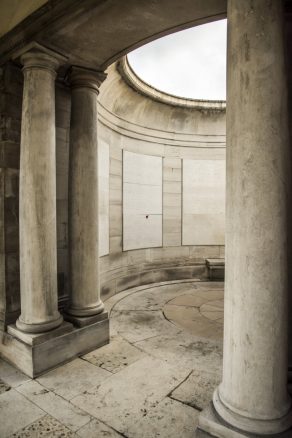
Loos Memorial: small circular court containing Panels 67 to 73
John was mistakenly commemorated on the Loos Memorial; his name will eventually be removed
Courtesy of Allan Hartley, High Bentham

The High & Low Bentham men who gave their lives
Top row (l-r): Rfn Ernest Knight Newhouse, Pte John Thornber, Reverend Theodore Bayley Hardy, Pte Richard Wilson, Pte Maurice Richard Bolton, Lieut John Barclay Clibborn, Pte William Throup, Pte Richard Wilcock Carr, A/Cpl William Robinson, Pte James Auton, Pte William Savage. Third row (l-r): L/Cpl David Percival Dixon, Pte John Emmott, Pte Francis Richard Townson, Pte John Adamthwaite, Pte Robert Carter, L/Cpl John Hutchinson, Pte Alfred Edward Gunn, Pte Ezra Stephenson, Pte Edwin Rawlinson Smith, Pte Richard Wearing, Lieut Basil William Ramsbotton. Third row (l-r): Spr Robert Clark, Act L/Cpl Thomas Wilcock, Cpl William Carr, Pte Lawrence Lancelot Dowbiggin, Pte Edward Magoolagan, Pte Isaac Rucastle, Pte Henry Taylor, Cpl Edward Ramskill, L/Cpl Edward Walton Briscoe, Pte Joseph Jackson, Gnr Ernest Wilcock. Fourth row (l-r): Capt Donald Morrison, Sgt Arthur Dean Blackburn, Pte James William Bell, Pte Leonard Nelson, L/Cpl John Edward Leeming, L/Cpl Albert Lister, Pte Percy Preston Whitfield, Cpl Tom Harry Smith, Cpl Thomas Walker Sanderson, Sgt William Patrick Tobin, Pte (Signaller) W. Wilkinson.
Courtesy of the artist, David Hartnup
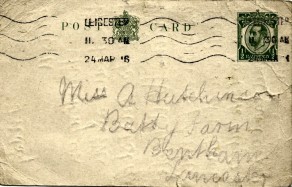
Post Card from John to his Sister Annie, 24 March 1916
The series of letters below are written to John’s mother (Annie), his sister (also Annie) and a few to Aunt Alice Jane Marsden (Aunt AJ), the sister of his father, William. At the time of writing John also had three brothers: Edward (referred to as Ted, Teddy or ‘our Ted’); William (‘our Willie’ or Will), and the youngest, Thomas (‘our Tom’)
This image and those below are courtesy of Sue Snell
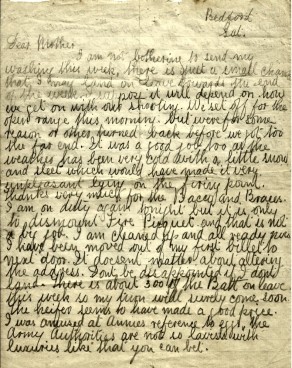
Page 1 of letter from John to his mother, 18 November 1916
Bostock and Wombells referred to in John’s letter was Bostock and Wombwell’s travelling Menagerie
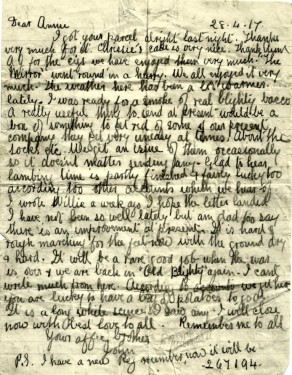
Letter from John to his Sister Annie, 28 April 1917
In his letter John mentions his new number - all men of the Territorial Force were renumbered in 1917
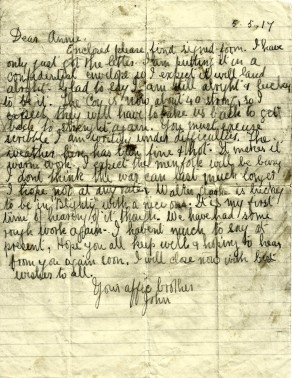
Letter from John to his Sister Annie, 5 May 1917
This letter was written after John’s battalion had been in action at the Battle of Bullecourt on the 3 May (see - View Additional Text)

Page 1 of letter from John to his Sister Annie, 7 July 1917
E. Smith, referred to in John’s letter, was Private Edwin Rawlinson Smith (q.v.), k. in a.,12 May 1917
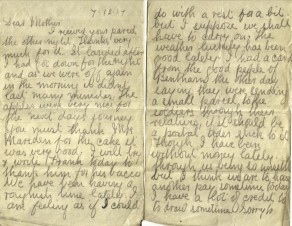
Pages 1 and 2 of letter from John to his mother, 7 December 1917
In this letter John writes that: "We have been having a roughish time lately." This is referring to the Battle of Cambrai, 1917 (20th November - 3rd December) in which his battalion had taken part.
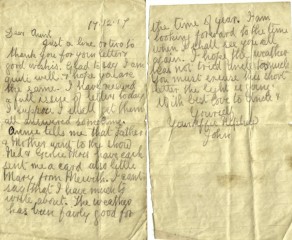
Pages 1 and 2 of letter from John to his Aunt Alice (Alice Jane Marsden), 17 December 1917
John mentions ‘little Mary from Mewith’ in his letter. Mary was the daughter of John’s brother, William
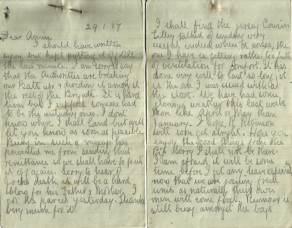
Pages 1 and 2 of letter from John to his Sister Annie, 29 January 1918
In this letter John mentions the breaking up of his Battalion. The 2/6th Bn Duke of Wellington's (West Riding Regiment) was disbanded on the 31 January 1918 and its soldiers sent to other Battalions of the 186th Infantry Brigade
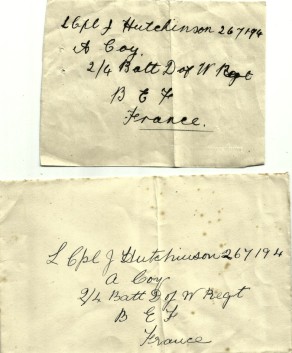
John’s address (31 January), after his transfer, that day, to the 2/4th Bn Duke of Wellington's (West Riding Regiment)
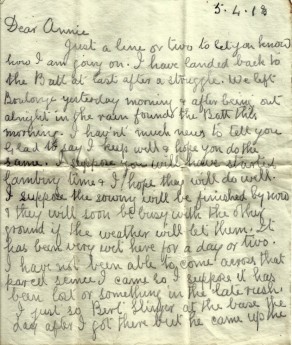
Page 1 of letter from John to his Sister Annie, 5 April 1918
John rejoined his battalion at Sailly-au-Bois (Pas-de-Calais). The 2/4th Bn had been involved in the German Offensive, during March, whilst John was on leave
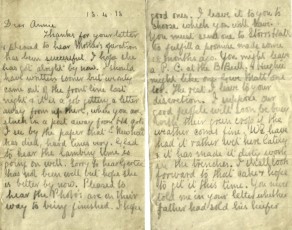
Pages 1 and 2 of letter from John to his Sister Annie, 18 April 1918
E. Newhouse, referred to in John’s letter, was Rifleman Ernest Knight Newhouse M.M. (q.v.), d. of w., 25 March 1918
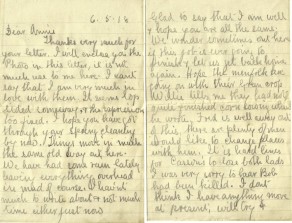
Pages 1 and 2 of letter from John to his Sister Annie, 6 May 1918
The Casson brothers, referred to in John’s letter, were Gunner Thomas Casson (q.v.), k. in a., 14 April 1917 and Private Robert Victor Casson (q.v.), k. in a., 13 April 1918
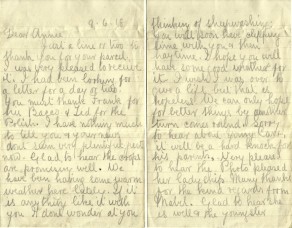
Pages 1 and 2 of letter from John to his Sister Annie, 9 June 1918
‘Young Carr’, referred to in John’s letter, was Private Richard Wilcock Carr (q.v.), k. in a., 21 May 1918; his elder brother, Corporal William Carr (q.v.), was k. in a., 7 November 1918
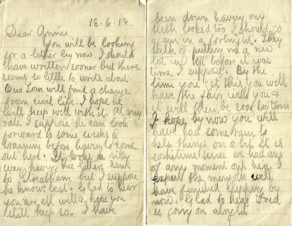
Pages 1 and 2 of letter from John to his Sister Annie, 18 June 1918
‘Our Tom’ mentioned in this letter was conscripted into the army in the last year of the war and served with the Civil Service Rifles (part of the London Regiment). No details of his war service can be found
View Craven Herald Articles
View Craven Herald Articles

07 July 1916
HIGH BENTHAM
Khaki Boys – Quite a good number of soldiers are having a quiet furlough this week, many on their last leave before going to the Front, namely Pte. David Hutchinson, who was at the landing at Suvla Bay and has been in hospital, Sergt. Bingley of the R.A.M.C., Pte. James Phillipson, Pte. Walter Clarke, Pte. John Jackson, Pte. Wm. Jackson, Pte. John Hutchinson of the Duke of Wellington’s, Pte. Gordon Leeming of the Canadians, Pte. Alfred Thompson, M.G. Section of the West Ridings and Pte. Rd. Johnson, Duke of Wellington’s, all looking fit.
16 August 1918
Private John Hutchinson, Bentham
The death in action is also reported of Private John Hutchinson, of the Duke of Wellington’s, the eldest son of Mr. William Hutchinson, of Batty Farm, Bentham. He volunteered, for service some two years ago with the ‘Duke’s’.
A letter from the deceased’s officer states that Lance-Corporal Hutchinson was killed in action about the 24th July. “I have known your son for some time now,” -adds the officer, “for we were in the ----- together and I always found him very willing and cheerful under the most trying conditions. His death is deeply regretted by the officers and men of his company, and they wish me to convey their deepest sympathy with you in your sad bereavement.
23 August 1918
Lance-Corporal Hutchinson, Bentham
We give a photograph of Lance-Corporal John Hutchinson, of the Duke of Wellington’s Regiment, son of Mr. Wm. Hutchinson, Batty Farm, Bentham, who, as recorded in last week’s ‘Herald’ was killed in action on the Western Front about the 24th of July. He volunteered for service about two years ago.
View West Yorkshire Pioneer Articles
View West Yorkshire Pioneer Articles

16 August 1918
Bentham Soldier Killed in Action
The following letter has been received by Mrs. Hutchinson the mother of the late Lance-Corpl. John Hutchinson from the Officer commanding his Company:– 2/4 Duke of Wellington’s, B.E.F. 6/8/18. Dear Madam – It is my painful duty to write and inform you that your son Lance-Corpl. Hutchinson was killed in action about the 24th July, 1918. I have known your son for some time now for we were in the 2/6th together and always found him very willing and cheerful under the most trying conditions. His death is deeply regretted by the officers and men of his Company, and they wish me to convey their deepest sympathy with you in your sad bereavement. – Yours truly, J. Storks, Captain O.C. 'A' Company.
16 August 1918
Bentham Soldiers’ Deaths
The death in action is also reported of Pte. John Hutchinson, of the Duke of Wellington’s. Deceased is the eldest son of Mr. Wm. Hutchinson, of Batty Farm, Bentham, and volunteered for service some two years ago with the Duke’s.
Comment on this Soldier Record
You can leave comments on this soldier record. Please note all comments will be manually approved before they appear on the website.

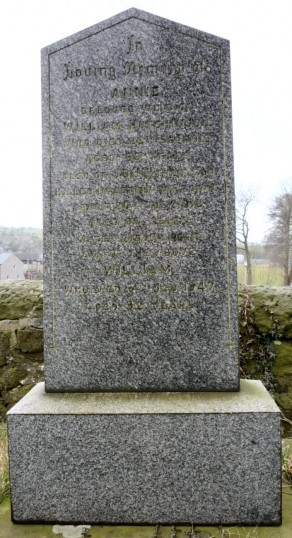
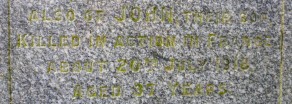
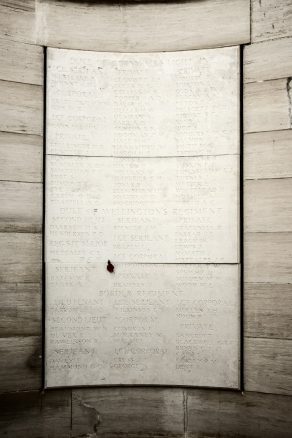

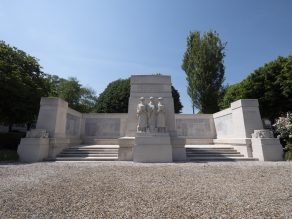

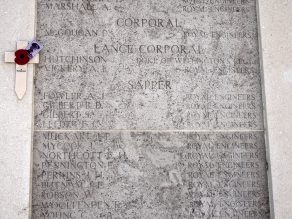

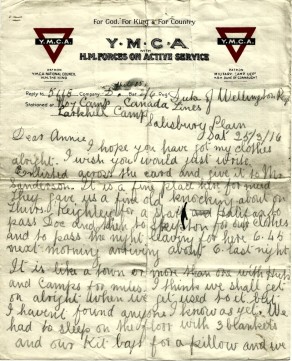

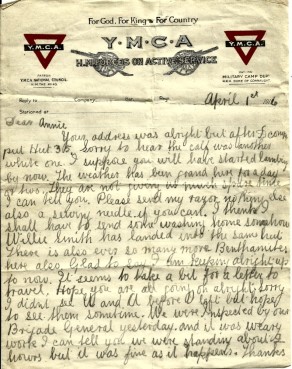
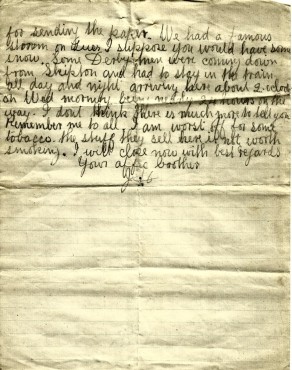
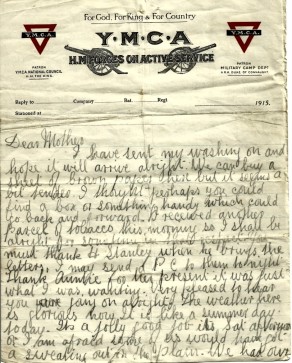
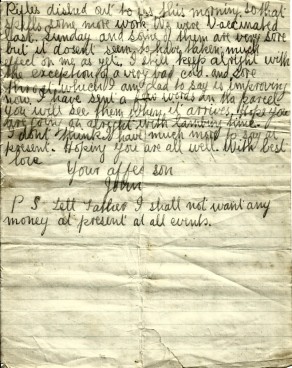
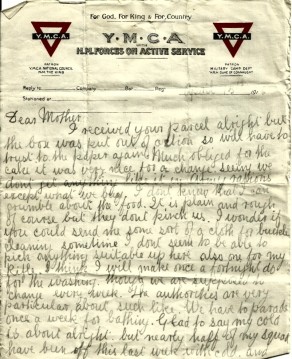
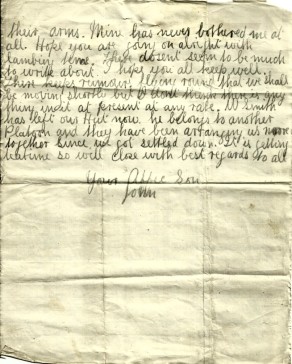
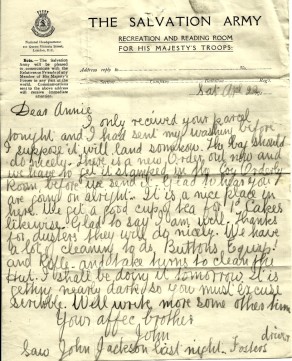
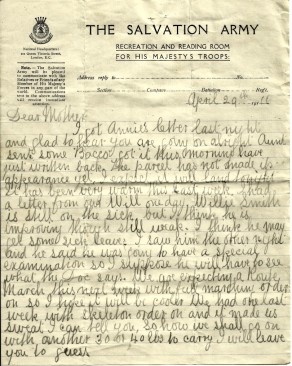
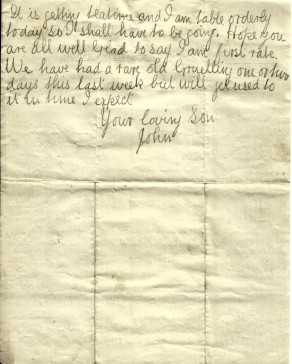
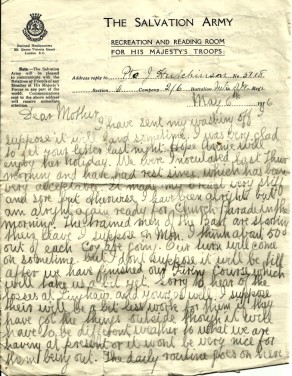
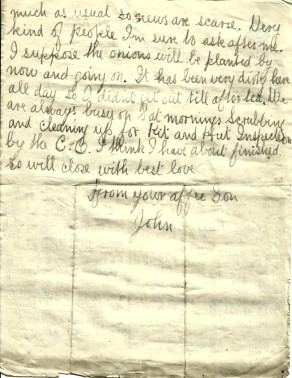
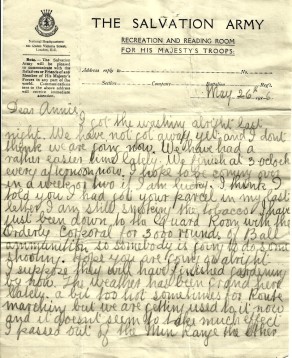
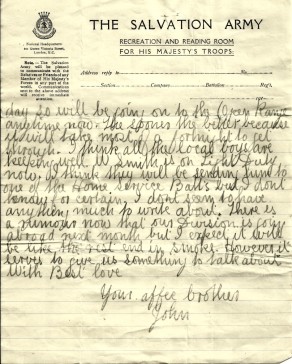
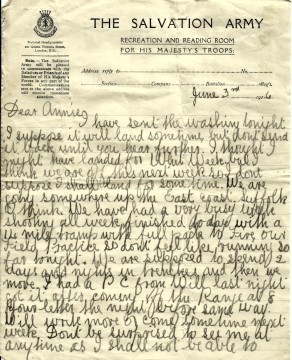
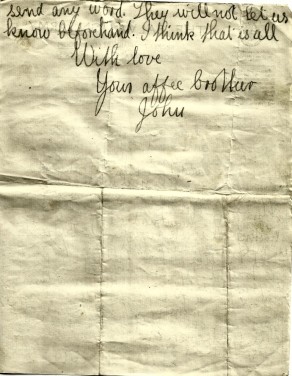
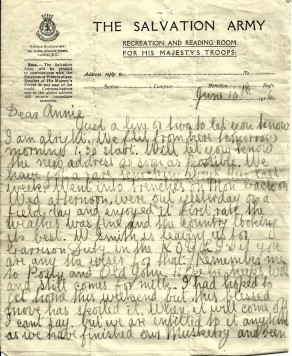
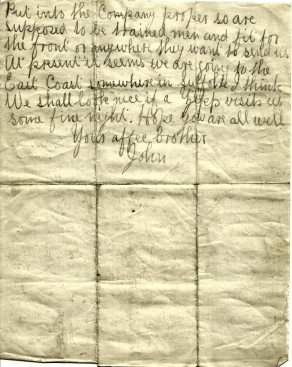
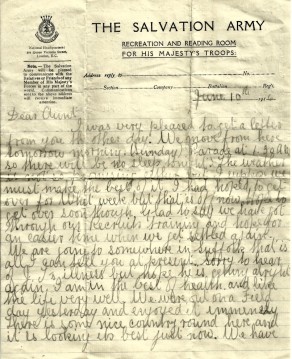
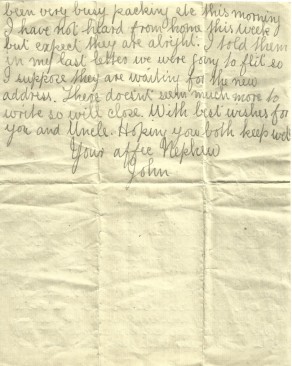
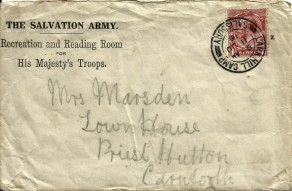
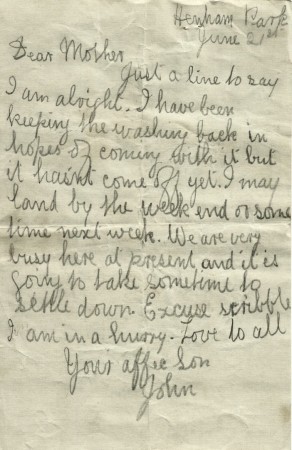
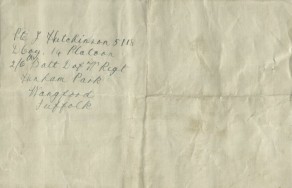
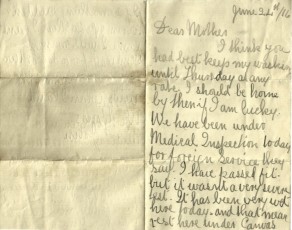


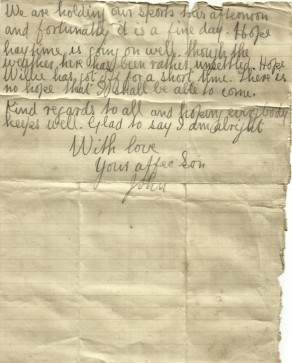

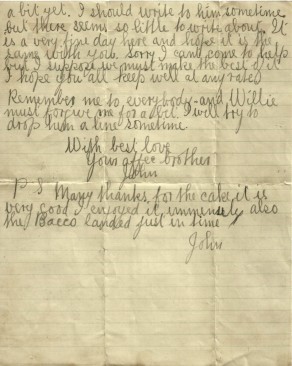


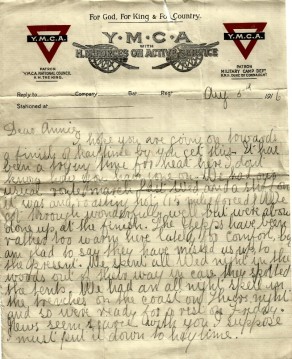
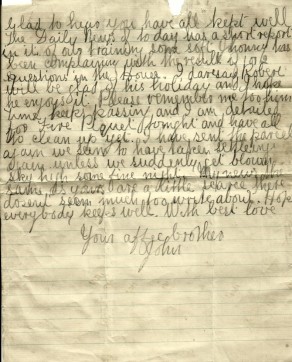
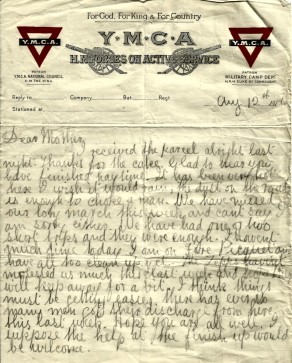


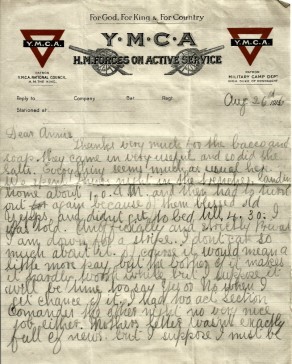
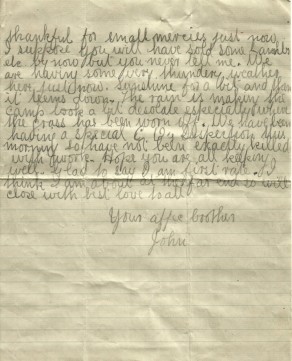
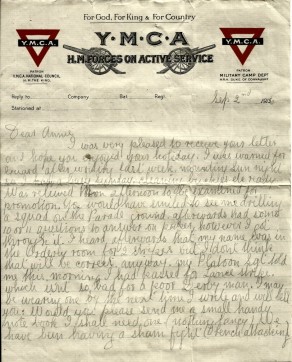
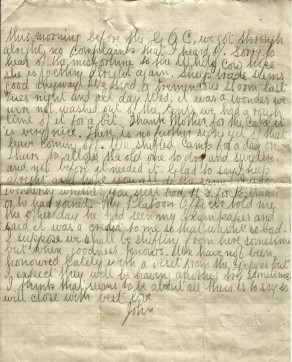
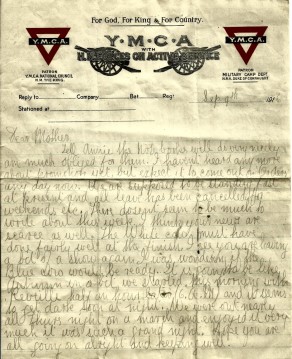
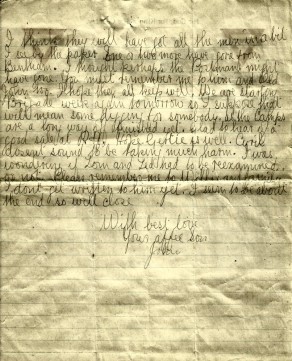
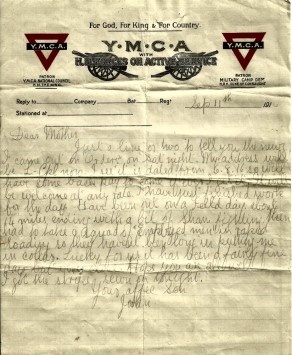




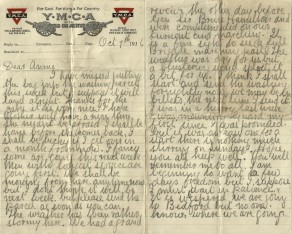
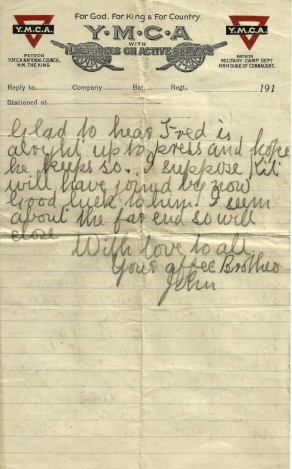


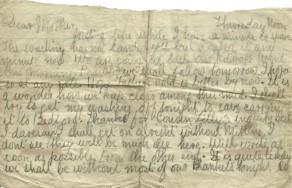
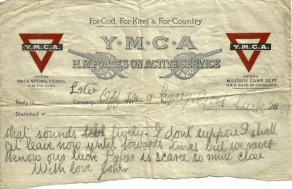
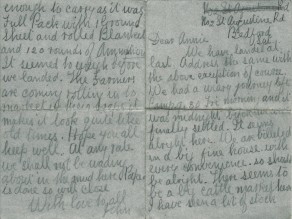
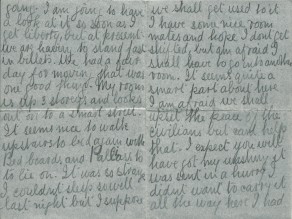
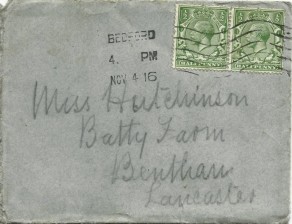
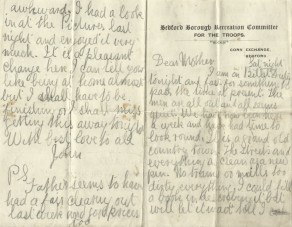

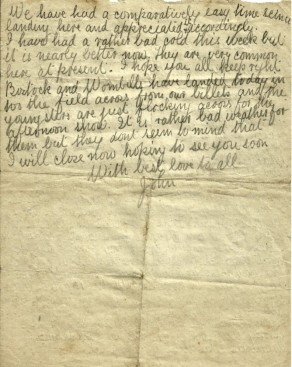
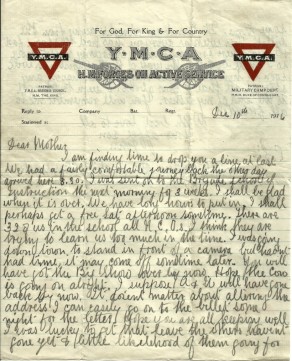
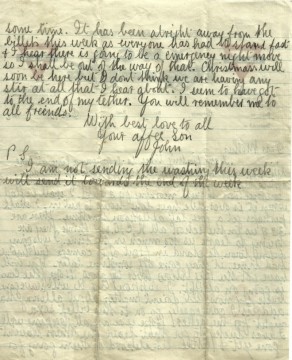
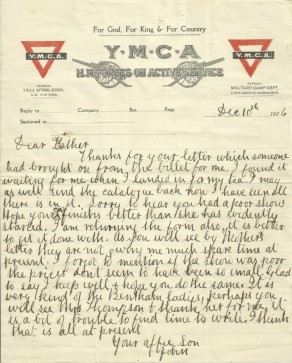
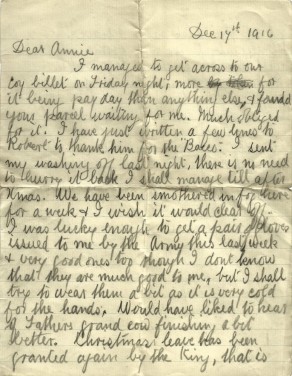
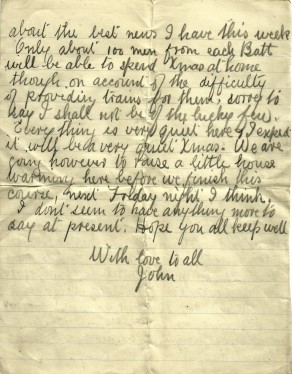
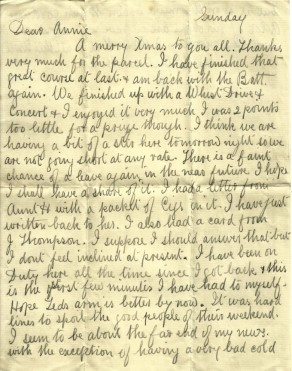
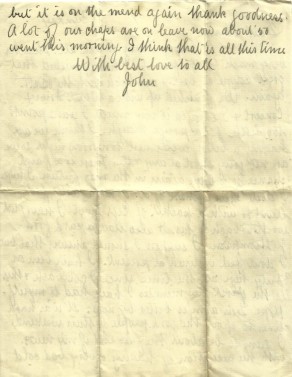
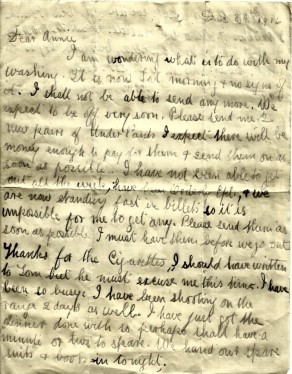
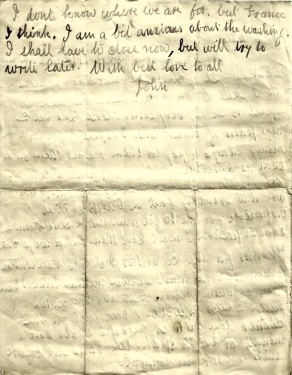
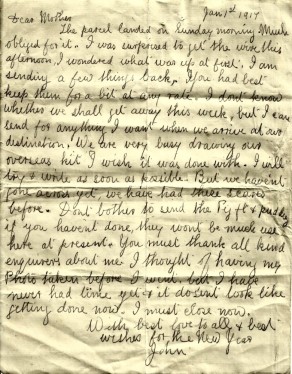
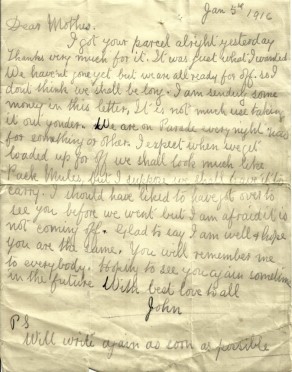
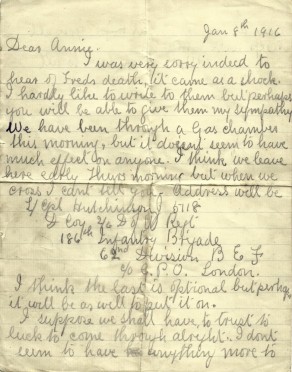
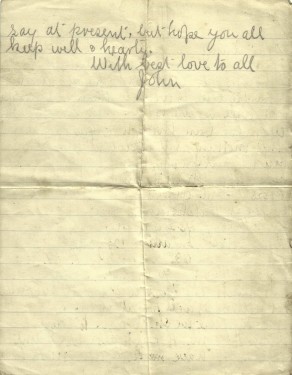

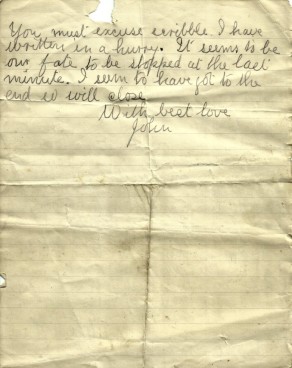
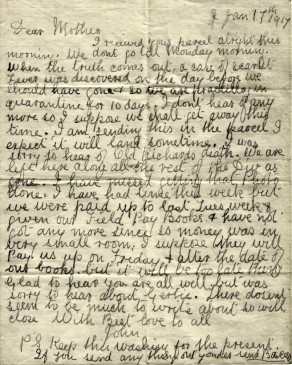
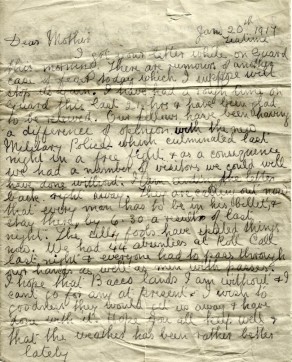


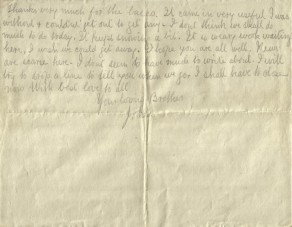

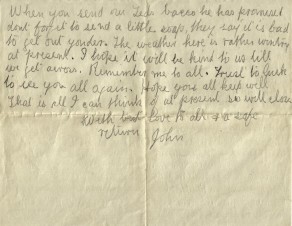
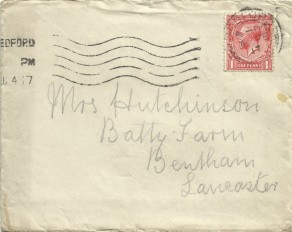
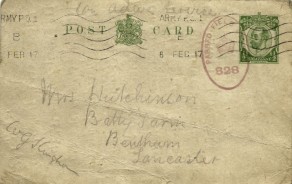
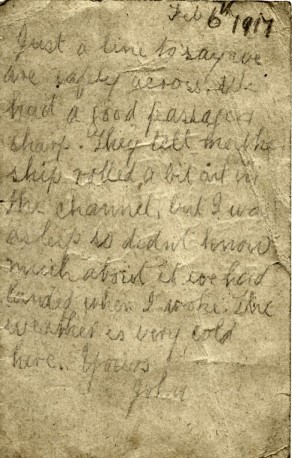
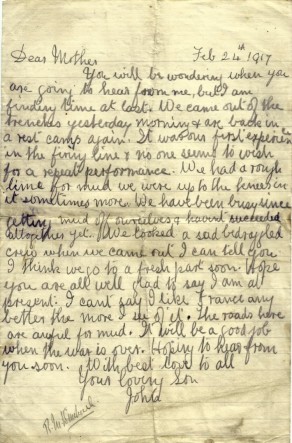
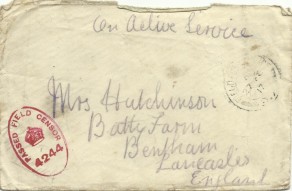



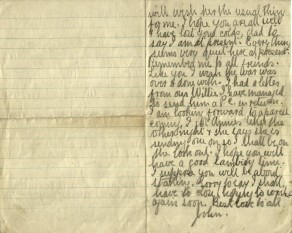


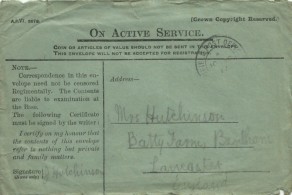
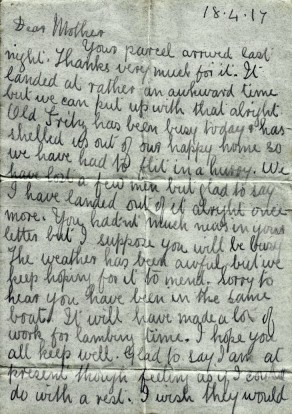
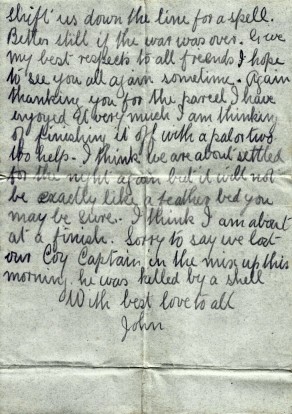
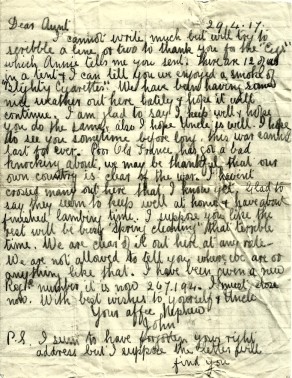
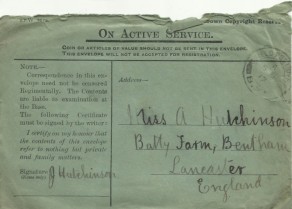
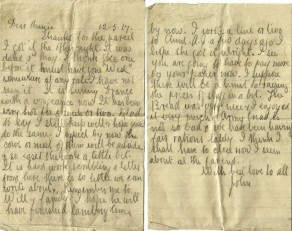
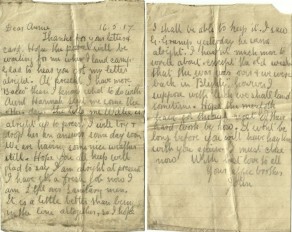


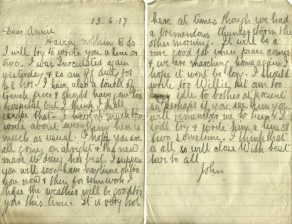
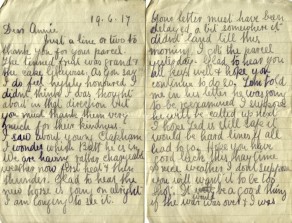
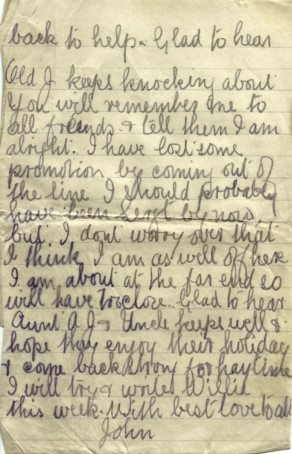

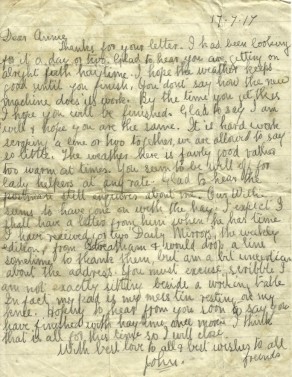

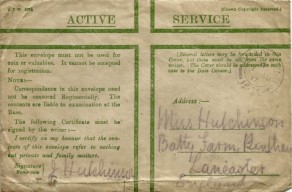
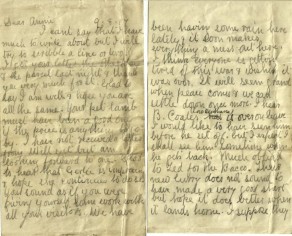



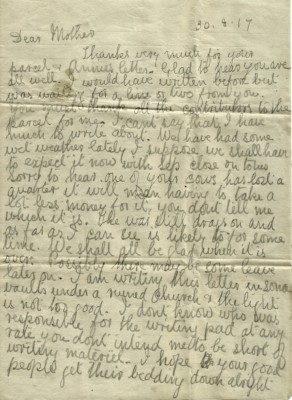

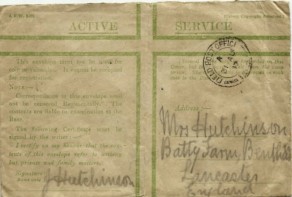
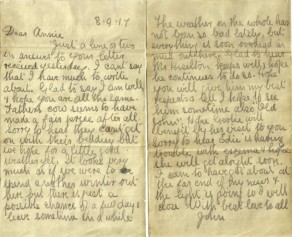

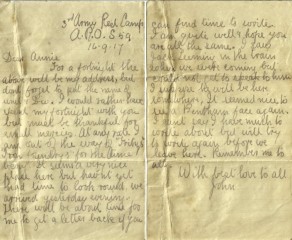
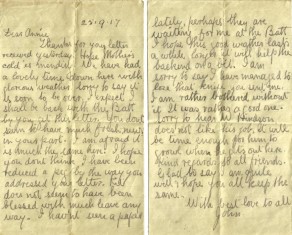
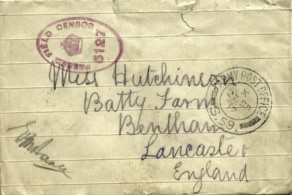

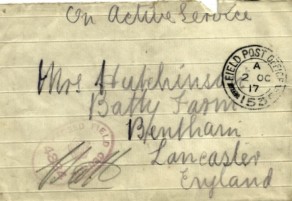



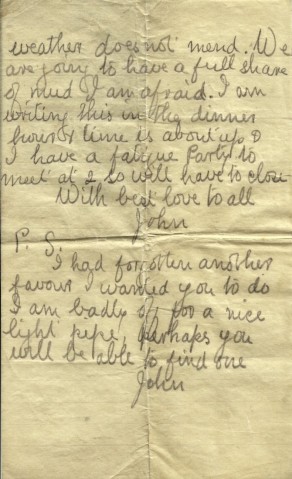

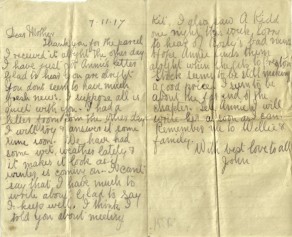

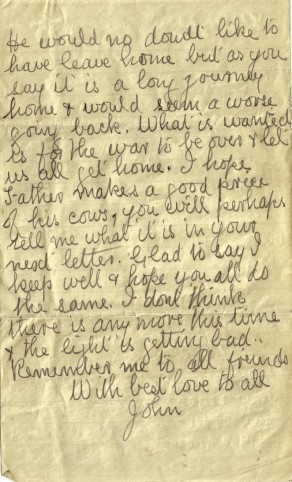
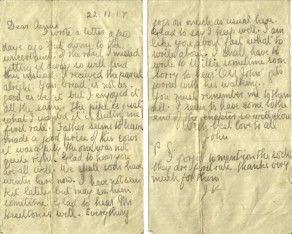
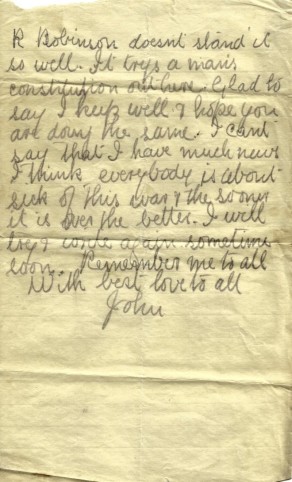

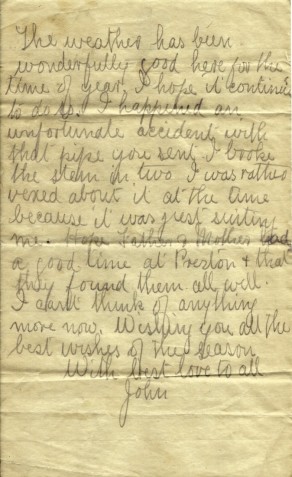
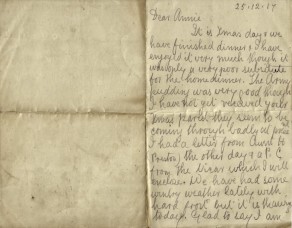
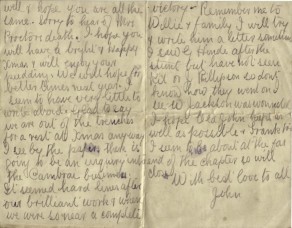
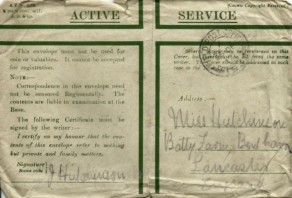

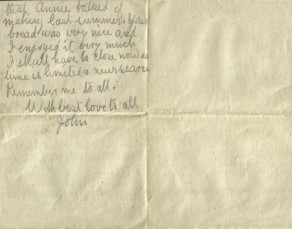

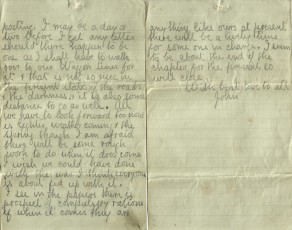
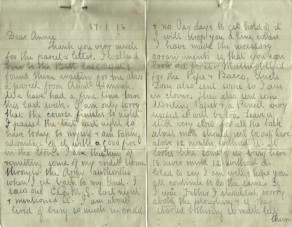
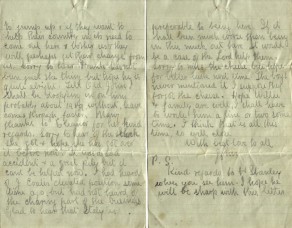
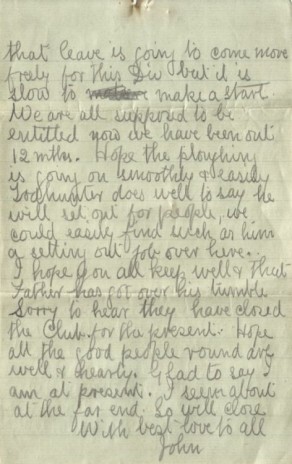

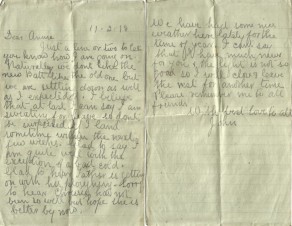

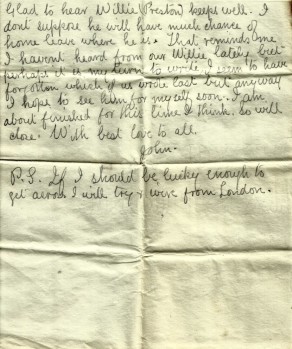

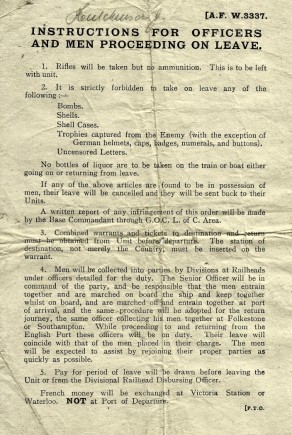

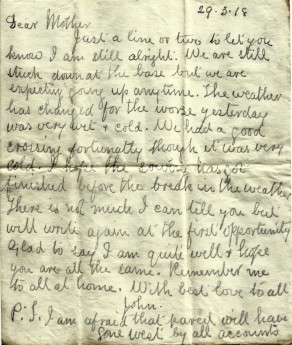
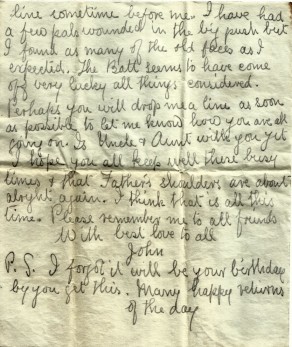
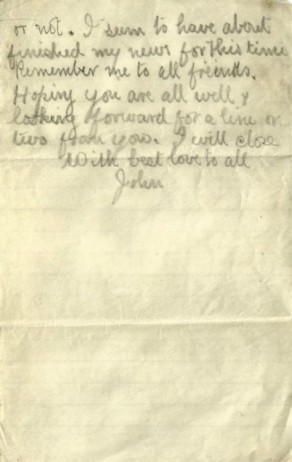
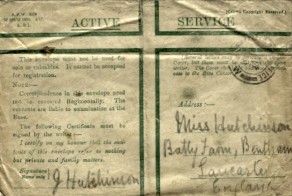



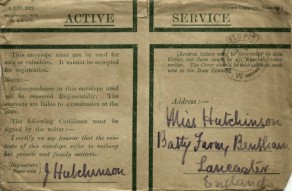
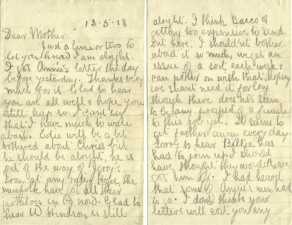
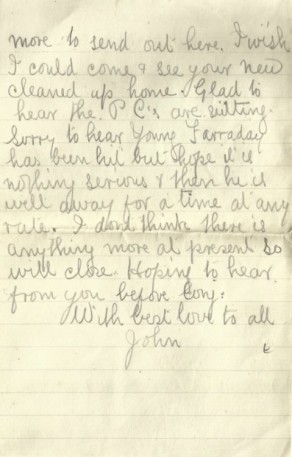

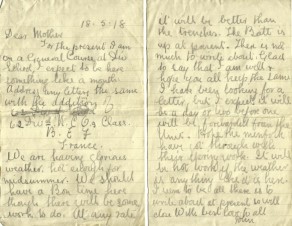
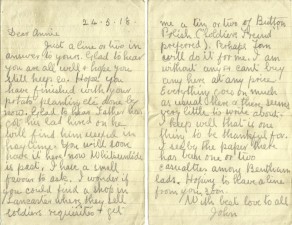


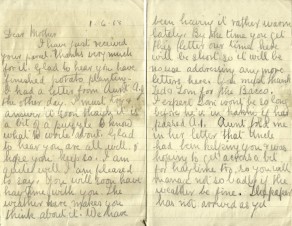
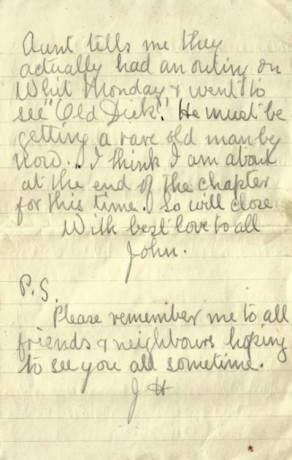

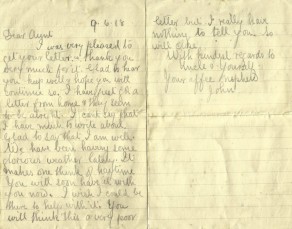

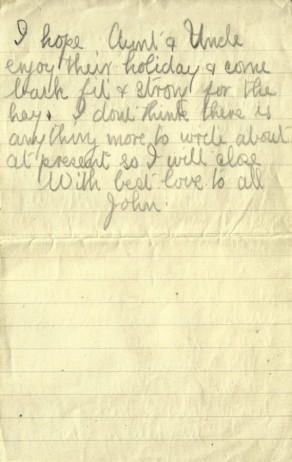
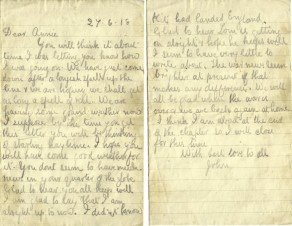
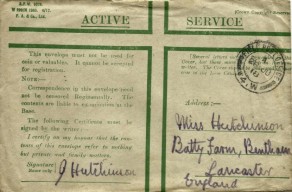
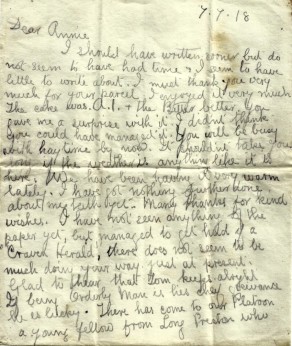


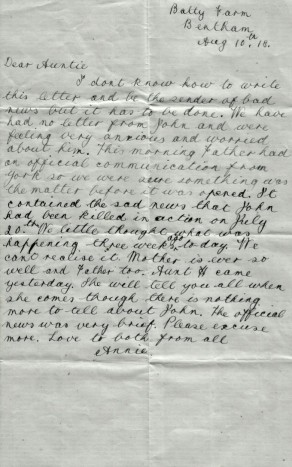
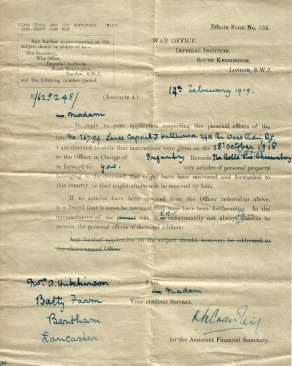
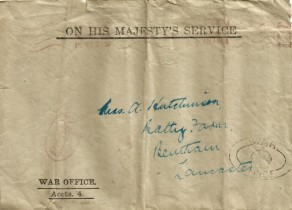



John Hutchinson was my great uncle. Very interested to read this compilation of information about him. Family members have been several times to visit the Loos Memorial at Dud Corner Cemetery where his name is recorded. As this year, 2018, marks a century since our great uncle died I, my brother and sister and two cousins hope to visit together.
For Susan Snell,
John’s profile was featured in Bentham News 376 July issue as the 43rd Bentham man to have died in the war.
In our tour of 2017 we did hope to visit the Loos memorial to find John’s name but we ran out of time. However, Loos Memorial and now Soissons will figure on our 2019 tour as we try to bring to a close our Bentham’s Part in the Great War project. You are welcome to join-us.
I am indebted to John Richardson from CPGW website to alerting me to this substantial update which in turn helps us to update John’s profile before we bring the project to a close.
Sincere Regards
Allan Hartley
High Bentham